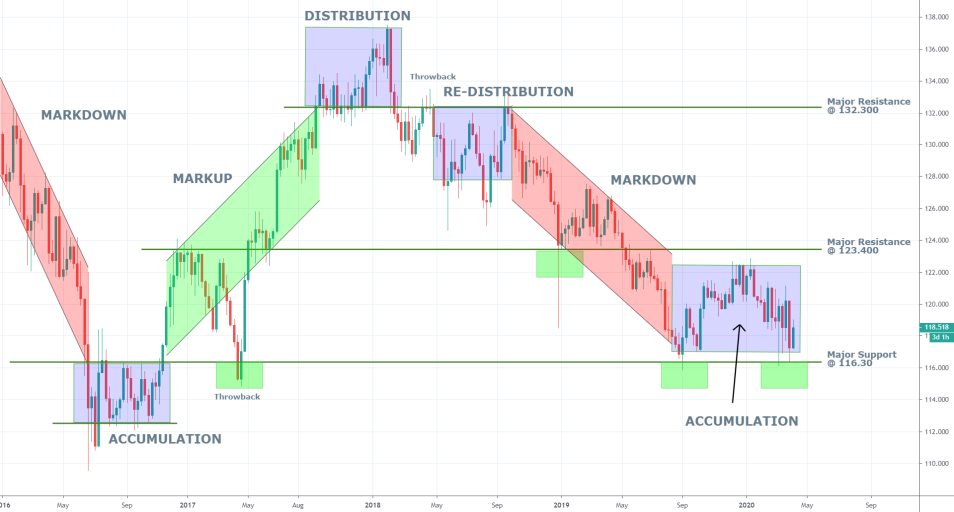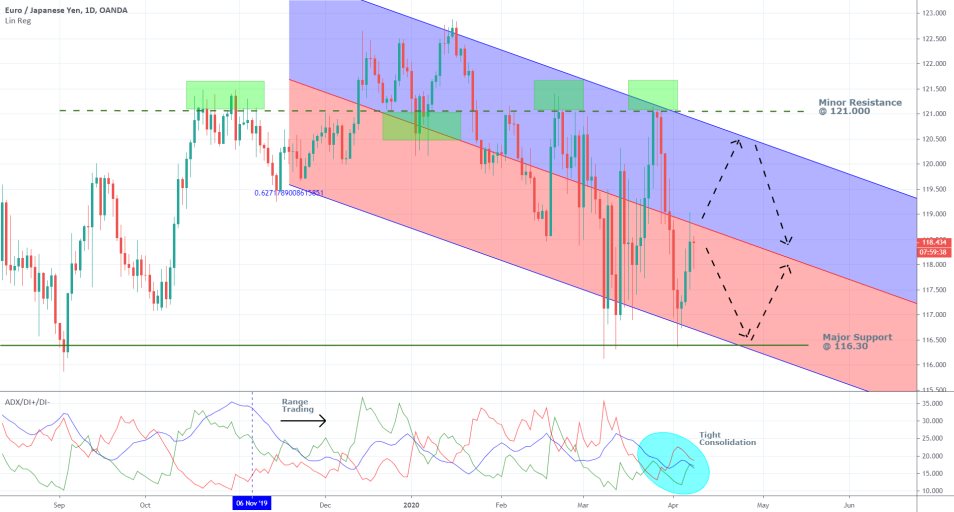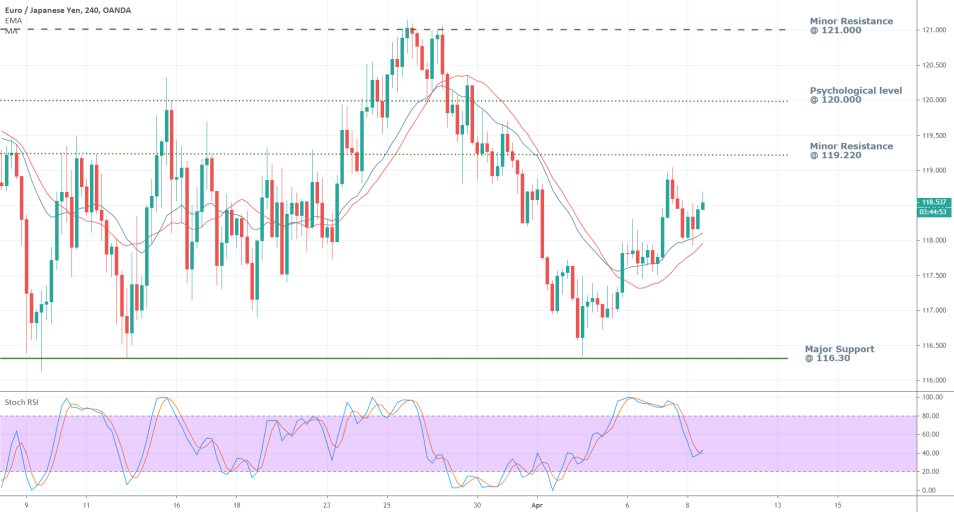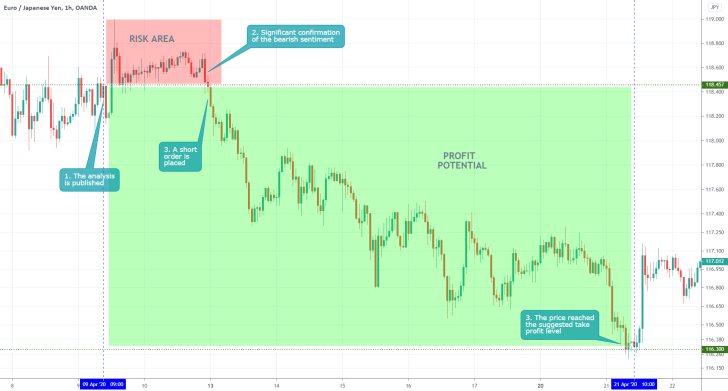The price action on the EURJPY pair has been fluctuating erratically over the last several trading days as the global developments keep affecting the underlying market pressures. The seemingly endless string of developments in the Eurozone and Japan has prompted massive upsurges followed by sudden plunges in the underlying price action, which has already confused many traders.
Even still, the Euro and the Japanese Yen have managed to maintain a relative parity between each other, as both currencies became sought after havens for traders and investors alike. That is the main reason why we do not see a massive spike up or dropdown on the chart, but rather an intermittent price action loosely contained within the boundaries of a significant range.
As the world continues to ramp up its efforts in battling the deadly coronavirus, there are now early indications suggesting Europe might be close to surpassing the peak of confirmed cases. This has reinvigorated European investors’ optimism to a certain degree, as the initial shock from the outbreak is now expected to start diminishing gradually.
Meanwhile, the situation in Japan appears to be worsening, as the government was forced to impose a national lockdown on rising numbers of confirmed cases in Tokyo and elsewhere.
Both of these developments are likely to impact the underlying market pressures, likely leading to new directional trading on the EURJPY. That is why today's analysis examines the underlying range that the pair currently finds itself in. The study delineates the likely scenarios in which the price action can either break out above the range's upper boundary or break down below its lower edge.
1. Long Term Outlook:
The weekly chart below illustrates the muted price action that has become the norm ever since the global markets started suffering from the pandemic. Prior to that, the price action had been trading in distinctly separated Accumulation and Distribution ranges, separated by Markups and Markdowns.

The most recent Accumulation range is entirely contained within a broader area with its lower boundary being the major support level at 116.30, and its upper limit is represented by the major resistance level at 123.400. Breaking above/below these confinements is going to be of crucial importance for the development of a potential new trend in either direction, as these boundaries represent significant turning points.
This can be ascertained by the two failed breakdowns below the major support in spite of the massive adverse volatility that was supporting them at that time. The 116.30 price level has been established as a substantial support level after the last transition of the market from Accumulation to Markup. The level had served as an upper boundary for that previous Accumulation, but once the price action had broken out above it, the level became a prominent support. This was confirmed by the subsequent throwback, which bounced back up from it. Hence, the current price action is going to have a tough time ahead in breaking down below the major support at 113.60, which is likely to serve as a turning point for any minor downswings in the near future.
Meanwhile, the prominence of the major resistance level at 123.400 was established on two separate occasions during the establishment of the last Markup. Additionally, it was tested in December 2018, when it held back a massive selloff. The only evidence left from that temporary ripple in the price action is the gigantic lower shadow of that candlestick.
2. The Diverging Challenges Ahead for Europe and Japan:
In light of the most recent developments, the fundamental factors currently affecting the EURJPY are influenced by the different challenges faced by both Europe and Japan.
- The Situation in Europe. Europe has really felt the hammer stroke from the rampant spread of the disease, which has ravaged especially hard through Southern Europe in countries like Italy and Spain. Nevertheless, now early indications are pointing to the likely surpassing of the so-called peak of the outbreak, which is giving people and policymakers in affected areas reasons to expect the worst is behind them. This does not mean that the epidemic is over, but it gives them a chance to regain the initiative.
Reportedly, leaders in Italy, Germany, and other European states have already started drawing plans for the gradual reopening of their economies, so that individuals can begin returning to their workplaces.
“Italy is advancing plans to gradually loosen stringent restrictions on public life as Europe’s exit from measures to contain the coronavirus begins to take shape […] Prime Minister Giuseppe Conte’s government is hammering out an approach that foresees the full return to normal life taking months, according to people directly involved in the talks.”
These news present investors with a glimmer of hope that the worst for Europe might indeed be over, and that the economic activity may soon start to stabilise.
In addition to that, European Finance Ministers are currently ironing out plans for a massive rescue package, which is going to provide a significant boost for the reeling European economies at the start of the recovery process. The negotiations have been arduous due to major disagreements but these are not expected to ruin the advancement of the rescue plan altogether.
All of these developments are likely to make the euro a much more sought-after asset for international investors, as the perceived stabilisation process in Europe is going to make the single currency more competitive.
- The Situation in Japan. In the early days of the global outbreak, Japan was considered as one of these states that were handling the situation relatively well. There were fewer confirmed cases than other countries, and the rate of spread seemed to be slower than in other places. The situation, however, has changed for the worse since then, and the rate of infection is speeding up.
Japanese Prime Minister Shinzo Abe was forced to declare a state of national emergency in Tokyo, Osaka and other areas, which is undoubtedly going to dampen the economic growth prospects in Japan’s wealthiest centres even more.
Meanwhile, the Bank of Japan’s Governor Haruhiko Kuroda warned against the continuous danger from the virus for Japan’s financial system in a meeting with the Bank’s branch managers.
“The spreading novel coronavirus is having a serious impact on our economy. The economic outlook is extremely uncertain.”
All of these developments project a very gloomy outlook for the Japanese economy over the next quarter, with some analysis weighing on a contraction of more than 10 per cent in Q2. Thus, the recovery process in the country is not going to start before the second part of the year. All of these developments are going to put pressure on the Japanese yen, which, albeit being a safe haven, is likely to lose some of its competitiveness to more ‘stable’ currencies.
3. Short Term Outlook:
As can be seen on the daily chart below, the broader Accumulation range (the one outlined on the weekly chart above) on the EURJPY has formed a marginal regression channel in the shorter term. The price action is likely to continue threading within its boundaries for the foreseeable future until the underlying market pressures become more pronounced and thereby prompt a new breakout/breakdown.

The dotted arrows represent the likely trajectory of the price action while the EURJPY remains threading within the boundaries of set Accumulation. That would continue to be the case until the underlying market sentiment starts favouring the development of a new directional trend.
The ADX is underpinning the range-trading environment, which has become the norm since November 2019. It is currently forming an interesting tight consolidation, which is typically found during stretches of especially muted price action like the current one. Such consolidations are commonly found prior to the emergence of massive new trends, as they illustrate the height of the Accumulation/Distribution phases. Hence, we can be seeing the final days of the current Accumulation's development, prior to the formation of a new directional trend.
The 4H chart below highlights the most recent bullish swing, which is nearing its first major obstacle – the minor resistance level at 119.220. The 20-day EMA is threading above the 20-day MA, which is illustrative of the bullish momentum’s prevalence in the short term. However, the RSI seems to be illustrating the currently rising selling pressure, which could be explained by more and more traders betting on a new bearish downswing. Hence, the aforementioned Accumulation range’s formation is likely to continue developing in the immediate future for as long as the underlying indicators keep demonstrating such mixed data.

4. Concluding Remarks:
The recent fundamental developments seem to be pointing to the likely strengthening of the pair in the midterm. That is so because aggregate demand for the euro is expected to surge as Europe recovers from the virus. Meanwhile, the economic situation in Japan is likely to continue worsening at least until the end of the current quarter, which is going to strain the yen. Consequently, the EURJPY is more likely to form a new bullish trend as the situation continues to evolve.
This new trend, however, should emerge from the current Accumulation range, which remains quite robust. Judging by the current behaviour of the price action, the pair is likely to continue threading within a range in the immediate future until the Accumulation is completely exhausted.

- While the analysis was quite right in expecting the price action of the pair to slide towards the lower boundary of the Accumulation range towards 116.300, it overestimated the buying pressure that was driving the euro at that time. The EURJPY did not establish a new Markup afterwards, but instead the price continued to plummet in the mid-term. Whenever the market is being driven by once-in-a-decade events such as the coronavirus crisis, it is difficult to make long-term projections of the underlying price action. Hence, it is better to base your trading positions only on existing evidence at the present, in order to prepare for adverse uncertainties in the future.
Disclaimer: Your capital is at risk! Trading and investing on the financial markets carries a significant risk of loss. Each material, shown on this website, is provided for educational purposes only. A perfect, 100% accurate method of analysis does not exist. If you make a decision to trade or invest, based on the information from this website, you will be doing it at your own risk. Under no circumstances is Trendsharks responsible for any capital losses or damages you might suffer, while using the company’s products and services. For more information read our Terms & Conditions and Risk Disclaimer.





















